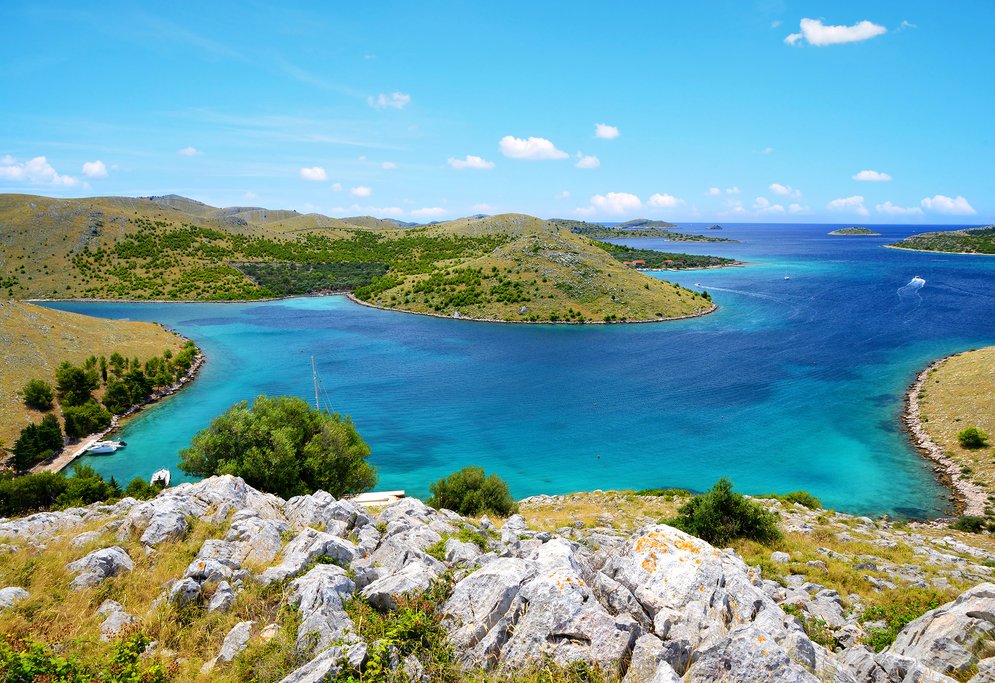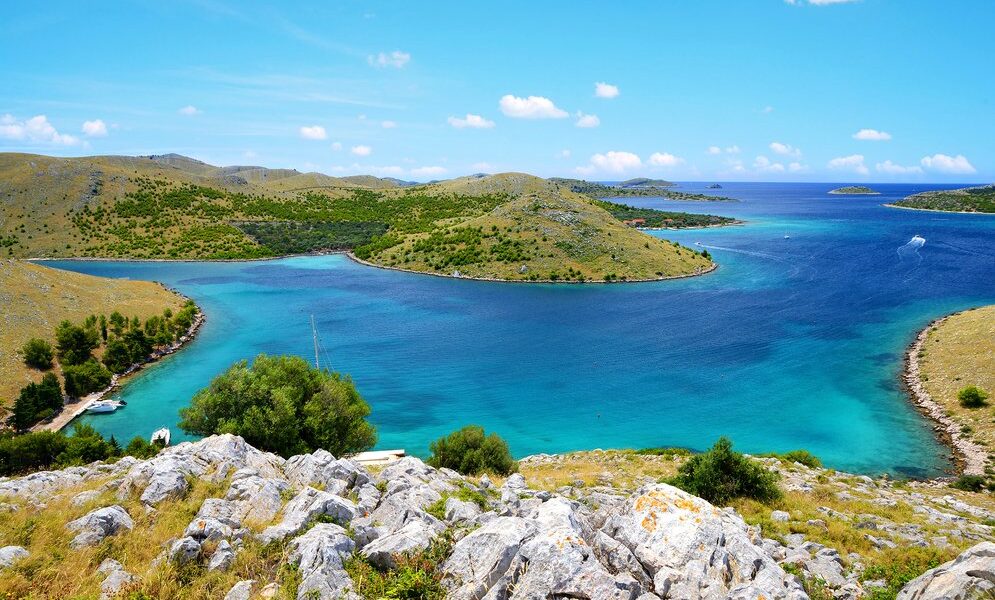
A national park like no other, Kornati is an archipelago just off the Dalmatian Coast. With few year-round residents, they offer a rugged landscape and breezy beaches with sparkling waters. They may not be a breeze to get to, but they’ve charmed visitors for centuries with their remote “desert island” feel. Thanks to Croatia’s newfound popularity, taking a tour through the 140 islands (89 of which belong to Kornati National Park) is easier than ever.
## Unveiling the Wonders of Kornati: A Detailed Exploration
Stretching along the captivating Croatian coastline between the historic cities of **Zadar** and **Šibenik**, the Kornati archipelago presents a mesmerizing tapestry of islands, islets, and reefs. This breathtaking natural wonder is geographically divided into two distinct regions: the Upper Kornati, known as the *Gornji* Kornati, and the Lower Kornati, referred to as the *Dornji* Kornati. The archipelago derives its name from **Kornat**, the largest island within its bounds. Adding to the area’s unique character is the administrative island of **Murter**, conveniently connected to the mainland via a bridge, offering easy access for visitors eager to explore this stunning maritime landscape.
The islands of Kornati possess a unique and compelling character. Some exude an eerie and desolate beauty, characterized by their rugged karst terrain, riddled with fascinating caves, hidden grottos, and intriguing cracks just begging to be explored. Others are surprisingly fertile, supporting thriving vineyards, lush olive groves, and bountiful orchards. These productive areas attract a seasonal influx of farmers who diligently tend to the land, contributing to the local agricultural landscape and economy. The extended coastline of the island of **Kornat** plays a crucial role in creating a protected expanse of water. This sheltered environment allows boats to navigate with ease, gracefully slaloming through the narrow channels that weave between the islands, sheltered from the powerful open sea waves. The calm and tranquil waters surrounding the islands have fostered the development of a unique micro-climate beneath the surface. Here, the familiar Adriatic marine life intermingles with rare and extraordinary species of algae, vibrant coral formations, and diverse mollusks. This rich underwater ecosystem offers an unparalleled experience for swimming and snorkeling enthusiasts, providing a glimpse into a vibrant and unique aquatic world.
## Planning Your Kornati Adventure: A Comprehensive Guide
Gaining access to the Kornati National Park necessitates travel by boat. The relatively compact area of the park, spanning less than 13 square miles, belies the sheer number of landmasses contained within. Some of these landmasses are so minuscule that they barely qualify as islands. Additionally, the largely uninhabited nature of the islands means that overnight accommodation is unavailable. Therefore, regardless of the distance you venture, it is essential to factor in sufficient time for a return journey. Fortunately, an array of boating options are available to suit diverse preferences and budgets. These include renting your own private boat, chartering a private vessel (either a sailboat or a speedboat) complete with a skilled captain who expertly navigates the waters, allowing you to fully immerse yourself in the stunning scenery, or embarking on a full-day kayaking adventure for a more active exploration.
Opting for a private boat rental grants you the freedom to explore the islands in any order you desire. You can even drop anchor in one of the many picturesque bays and secluded coves and spend a tranquil night under the stars. Should you choose to join a guided tour, expect a full-day excursion, typically inclusive of lunch, that encompasses several different islands. The availability of tour options may vary depending on your chosen embarkation point, be it **Zadar**, **Šibenik**, or another location along the picturesque coastline in between.
During the peak tourist season, which spans July and August, the Kornati Islands experience a surge in popularity, with multiple tours departing daily. Many of these tours operate on smaller boats, designed to accommodate intimate groups. However, the increased number of visitors during this period necessitates booking in advance to secure your place, especially if you have flexibility in your travel dates and can select the ideal day for your visit. The shoulder seasons, encompassing April to June and September to October, offer a more serene experience with slightly fewer tours operating. However, this also translates to fewer tourists to contend with, allowing for a more tranquil exploration of the islands.
## Unveiling the Treasures: What to See and Do in Kornati
The manner in which you experience the Kornati Islands is largely dictated by the type of tour you select. However, visitors to this remarkable archipelago can anticipate a harmonious blend of land and sea activities, taking full advantage of the distinctive limestone-karst terrain and the thriving underwater ecosystem.
A highly recommended initial hike, offering breathtaking panoramic views of the entire archipelago, is the ascent to the summit of either Metlina or Opat peaks, located on the main island of **Kornat**. Given the islands’ sparse terrain, which provides limited shelter, it is advisable to commence your hike early in the morning. Remember to bring essential items such as hats, ample water, and sunscreen to protect yourself from the elements. Take frequent breaks to rest, particularly if the temperature is rising. On the islands of **Mana** and **Klobučar**, you can embark on a captivating walk along the dramatic cliffs that rise majestically from the ocean. Marvel at the sharp, rugged terrain that was sculpted over millions of years. For those with a keen interest in geology, two easily accessible educational trails on the islands of **Trtusa** and **Panitula** provide insightful information about the region’s natural and human history.
The Kornati archipelago is home to a diverse array of wildlife, although many species can be challenging to spot. Keep an eye out for reptiles, such as snakes and lizards, as well as various bird species, including eagle owls, buzzards, peregrine falcons, and kestrels. However, the true allure of the Kornati Islands lies beneath the surface of the water. Here, a kaleidoscope of brightly colored fish, elusive moray eels, and fascinating crustaceans dart in and out of caves and grottos, seeking refuge amongst vibrant coral and intricate sponges.
If you hold a PADI certification, consider joining a SCUBA diving excursion to explore the underwater wonders firsthand. Alternatively, simply equip yourself with goggles and a snorkel and observe this mesmerizing underwater realm from the surface as you float serenely. Most diving companies operating in the area adhere to strict Croatian guidelines and are primarily located on the island of **Murter**. Snorkeling, on the other hand, offers a more accessible option, requiring minimal equipment and allowing you to explore independently from a boat or the beach.
## Sun, Sand, and Sea: The Beaches of Kornati
The Kornati Islands are a haven for swimming enthusiasts, boasting a diverse range of beaches to suit every preference. Choose from tranquil bays with sandy shores to dramatic cliffs that are just low enough to safely jump from, yet high enough to provide a thrilling experience. Best of all, thanks to the archipelago’s secluded nature, you’ll rarely have to share your chosen swimming spot with more than a handful of people. For the most exceptional swimming locations, head to **Telascica** and **Saharun**, pristine bays located on the island of **Dugi Otok**. Alternatively, explore **Lojena** beach on the island of **Levrnaka**, or **Opat**, a large bay on **Kornat** that features a restaurant and a convenient boat dock.
For those seeking to incorporate a touch of cultural heritage into their outdoor adventures, the islands are dotted with intriguing ruins. Explore the remains of the ancient city of **Colentum**, located at the base of Mount Gradine on the northern tip of **Murter**. Flourishing during the reigns of Nero and Vespasian, the city was likely destroyed by an earthquake in the 2nd century AD. Today, it stands as an open-air archaeological park, inviting visitors to wander through its remnants, examine informative signs depicting the ancient city’s layout, and discover coins and pottery unearthed at the site. On **Kornat**, the Byzantine Fortress of **Tureta** offers a captivating glimpse into the past, with its stone archway providing stunning views of the sea. Numerous centuries-old churches scattered across the islands further attest to Kornati’s enduring legacy.
## Finding Your Sanctuary: Where to Stay in Kornati
Given that most of the Kornati islands remain uninhabited, the accommodation options are somewhat limited. The island of **Murter** features several modest hotels and welcoming guesthouses, many of which offer private tours to their guests, providing the convenience of booking both your lodging and an excursion to the islands simultaneously. Additionally, several regulated camping sites are available across the islands, primarily on **Kornat** and the neighboring **Dugi Otok**. If you are traveling with your own boat, there are 16 designated locations within the park where you can drop anchor and spend a peaceful night.
## A Culinary Journey: Where to Eat in Kornati
While the Kornati archipelago may not boast an abundance of restaurants, the establishments that do exist more than compensate with their delicious, traditional dishes and their relaxed, island-inspired ambiance. **Kornati** has a long-standing tradition of sheep farming, so anticipate that local lamb dishes will feature prominently on the menus.
Given the archipelago’s location surrounded by water, you can expect the fish and seafood to be incredibly fresh, prepared in simple ways that enhance rather than mask their natural flavors. Grilling, the use of fresh herbs, and the addition of local olive oil are common culinary techniques. Most restaurants are concentrated on **Murter**, but you can also find a few establishments located near the more popular beaches, including **Opat** and **Telascica**.
B-599

